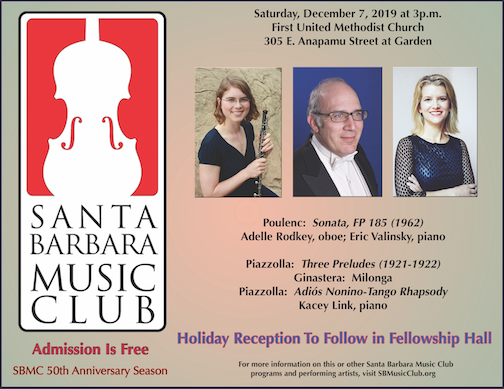
- This event has passed.
Santa Barbara Music Club 50th Season of Free Concerts
December 7, 2019 @ 3:00 am PST

On Saturday, December 7 at 3:00 p.m. the Santa Barbara Music Club will present another program in its popular series of beautiful classical-music concerts. Today’s roster features oboist Adelle Rodkey and pianist Eric Valinsky performing the Sonata for Oboe and Piano (1962) by Francis Poulenc. Pianist and scholar of Argentinian music, Kacey Link, concludes the afternoon’s program with Three Preludes for Piano and “Adiós Nonino” Tango Rhapsody by Astor Piazzolla; and Alberto Ginastera’s Milonga, his solo-piano arrangement of an earlier work of his, Canción al Arbol del Olvido (Song to the Tree of Forgetfulness), Op. 3. This concert will be held at First United Methodist Church, 305 E. Anapamu Street at Garden, Santa Barbara. Admission is free.
Toward the end of his starred life, Francis Poulenc (1899–1963) planned to write a series of sonatas that would feature each of the main woodwind instruments: flute, clarinet, oboe, and bassoon. He completed only three of the four, having died before composing a sonata for the bassoon. The remaining trio of sonatas stand, as many scholars agree, as some of his finest chamber works. They betray the technique and writing of a mature, skilled craftsman. The Sonata for Oboe and Piano (1962), dedicated to the memory of Prokofiev, has the honor of being the last major work in Poulenc’s oeuvre. Although speculating the intention of composers is a risky and often discouraged undertaking, themes of death and elegy certainly do emerge throughout this piece nested in moments of delicacy peacefulness. The scheme of the work inverts the typical fast-slow-fast organization of three-movement sonatas. This sonata has a slow-fast-slow scheme, and this afternoon’s performance by oboist Adelle Rodkey and pianist Eric Valinsky invites the listener into contemplation.
Upon the death of Argentinian composer Astor Pantaleón Piazzolla (1921–1992), the New York Times acclaimed him as “the world’s foremost composer of tango music.” Indeed, performers and scholars alike credit him with revolutionizing traditional forms of tango with nuevo tango, which incorporates both classical and jazz elements. Piazzolla composed Three Preludes for Piano in 1987, at the height of his maturity. Each of the movements, as pianist Kacey Link shows, incorporates elements of dance tracing to tango. The first movement, “Leijia’s Game,” is itself a tango. The second movement, “Flora’s Game,” is called a Milonga, which is a Brazillian-Portuguese dance related to a tango. The final movement, “Sunny’s Game,” is a valse, a tango-like version of a traditional waltz.
The milonga also reappears in the repertory of perhaps the most well-known Argentinian composer, Alberto Ginastera (1916–1983). He arranged his Canción al Arbol del Olvido (Song to the Tree of Forgetfulness), originally for vocal soloist and piano, for solo piano alone and renamed it Milonga (1948). This mournful folksong provides a good contrast to the mood of the works by Piazzolla, as it incorporates a slow habanera rhythm in a minor key. So characteristic of the music of the Latin Americas, Ginastera’s Milonga presents a fascinating study in negotiating cross rhythms.
Finally, Ms. Link concludes this afternoon’s program by returning to the music of Piazzolla, his “Adiós Nonino” Tango Rhapsody (1959), which pairs well with Ginastera’s Milonga with regard to its elegiac mood. This piece resulted from Piazzolla receiving news about the death of his father, Vicente Piazzolla. Within 30 minutes of receiving this devastating news, the composer rearranged and added new parts to a pre-existing piece of 1954, Nonino (“grandfather”). Unfortunately, Piazzolla lost his father while touring America and was in the throes of financial and professional setbacks, the confluence of which sent him into a deep depression. The piece is rife with the sorrow of Piazzolla’s losses and has become one of his most famous pieces, not least due to the tragic beauty of the melody.
The SANTA BARBARA MUSIC CLUB, the largest year-round concert series in Santa Barbara County, celebrates its 50th year of presenting its stellar concert series! SB Music Club concerts are free to the public, and display a wonderful diversity of historical musical periods and compositional styles, including beloved masterworks and exciting new and seldom-heard repertoire. Of the series, the Santa Barbara Independent exclaimed: “A beautiful day, a beautiful room, beautiful music … who could ask for more?” and Gerald Carpenter in Noozhawk.com declared, “Every Santa Barbara Music Club concert that I have ever attended has been a sensory joy as well as a consciousness expansion.”
A valued cultural resource in the community since 1969, the Music Club’s mission is threefold:
(1) Presentation of an annual series of concerts, free to the public.
(2) Aiding and encouraging musical education by the disbursement of scholarships to talented local music students.
(3) Presentation of community outreach activities, including bringing great music to residents of area retirement homes.
For information on this or other Santa Barbara Music Club programs and performing artists, visit SBMusicClub.org.


